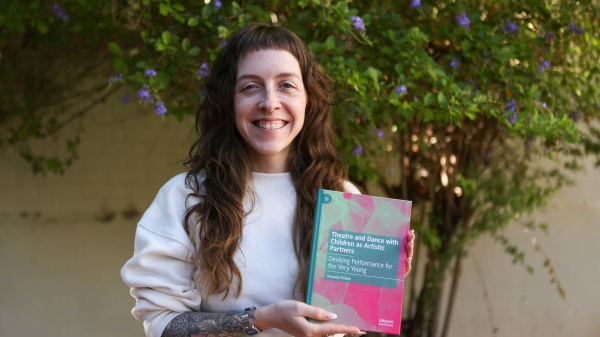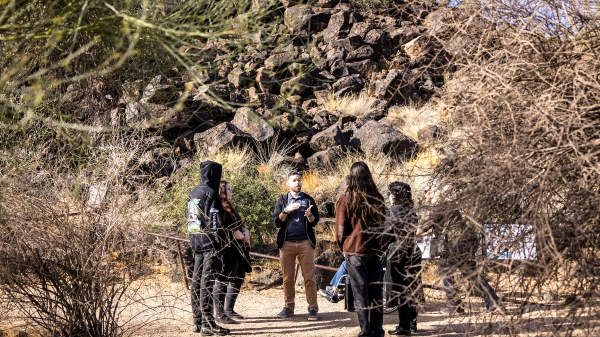Research on 'colorism' by ASU grad breaks new ground

"In the past five years at ASU, I have learned a good many things," said graduating ASU student Sayantan Mukherjee. "I could write an entire essay on that. However, there is one thing that usually secures the top place on the list—a remarkable balance between student and teacher life."
Editor’s note: This is part of a series of profiles for fall 2019 commencement.
Graduating Arizona State University student Sayantan Mukherjee believes that “quality education is the only way up.”
Mukherjee, who is originally from the small town of Dubrajpur in West Bengal, India, is setting into motion his own vertical mobility by earning a PhD in linguistics and applied linguistics this fall. He defended his dissertation, “Understanding ‘Fairness’ in India: Critically Investigating Selected Commercial Videos for Men’s Skin-Lightening Products” on Oct. 30.
“Sayantan Mukherjee stands out among our PhD students for his original and carefully strategized dissertation research,” said Karen Adams, a professor in the Department of English’s linguistics and applied linguistics program who chaired Mukherjee’s dissertation committee. “’Understanding “Fairness” in India’ breaks new ground in gender studies and in issues of colorism.”
Mukherjee’s innovative research on skin-color discrimination in India shines on a necessary light on a systemic problem. His dissertation study analyzed the language and semiotics (images and symbols) of YouTube commercials for skin-lightening products aimed at young, urban men in India. Mukherjee concluded that preferences for lighter skin — likely remnants of India’s time under British colonial rule — have become “naturalized” among makers and purchasers of these products.
In other words, in these Hindi-language advertisements, both company and consumer tacitly believe possessing lighter skin confers certain social benefits.
Mukherjee said he arrived as this choice of topic somewhat organically. “I was already interested in the discourse of television advertisements,” he explained, “and I became curious about how advertisements construct/portray gender stereotypes.” A visit home to India during summer break 2016 provided the specific focus.
“My friends and some acquaintances started reassuring me that my tanned skin/dark skin tone, thanks to the excess amount of sunlight in Arizona, should not be a problem for my marriage.”
Mukherjee was floored. He had been aware of skin-color discrimination faced by females in India, but had never considered males to be impacted. With that realization, Mukherjee said, he finally understood a small part of what Indian women had faced. “I genuinely feel sorry for my lack of awareness.”
“Once I returned to Tempe after the summer break, I soon invested myself in understanding and foregrounding this issue of colorism.”
Mukherjee cautioned that in Indian society, the issue is complex and addressing the biases and ideologies underlying skin-color discrimination will take time.
“There are people who have started campaigning against skin-color discrimination in India, but it is still very little compared to what we need,” he said. “Spreading awareness among people is important. Making them realize that idealized beauty standards are detrimental to the growth of a remarkably diverse society like India. Discouraging the use of skin-lighteners is a good starting point to tackle this issue as well, and it is so because of two reasons — it helps minimize skin-color discrimination and it saves people from using harmful chemicals on their skin just to attain a lighter tone that misleadingly denotes beauty or attractiveness for all genders.”
Mukherjee has presented his work at the annual conference of the American Association for Applied Linguistics, the top professional society in his field, and has been the recipient of several fellowships from the ASU Graduate College.
We visited with Mukherjee to get his thoughts on other aspects of his life at ASU — and to find out what’s next.
Question: What was your “aha” moment, when you realized you wanted to study in your field?
Answer: My “aha” moment had happened long before I joined ASU while I was doing my BA in English literature in India. I was studying the history of the English language and some interesting things about sound change, grammar, culture, etc. I realized there was so much more to learn about human language. My former professor at Visva-Bharati — the university in India I attended for my undergraduate studies — Dr. Anupam Das told me a lot about a discipline called “linguistics” that is dedicated to scientifically studying human language. With all eagerness, I would listen to him say how language as a system encodes both linguistic and cultural concepts. The very existence of language presupposes the excellence of human intelligence as a species. It was during this time that I found my passion. My BA in English was soon followed by two master’s degrees in linguistics at the University of Delhi and lately a doctorate in linguistics and applied linguistics at ASU.
Q: What’s something you learned while at ASU — in the classroom or otherwise — that surprised you, that changed your perspective?
A: In the past five years at ASU, I have learned a good many things. I could write an entire essay on that. However, there is one thing that usually secures the top place on the list—a remarkable balance between student and teacher life. I was fortunate enough to secure a teaching assistant position in the Department of English. It helped me understand what kind of life a college student usually leads to achieve his/her goals in the United States, and how significant the roles of the teachers are here. Coming from India, I had had no prior experience of the student life in the U.S., nor had I imagined being a TA teaching first year composition courses to young college students. I realized most students are hardworking. They are here because they want to be here; just like me. As a student, they struggle at various things like I do, and as a teacher, I can make their learning process as smooth and rewarding as possible — the same way I have had it from my teachers.
Q: Why did you choose ASU?
A: I chose a handful of schools to apply for my doctoral studies in the U.S. Arizona State University was one of my top preferences because of its faculty strength in the area I was interested in. Even in 2014, I was aware of the ASU’s reputation as a public university that prided itself on diversity and innovation. I must say, having secured a PhD at ASU, that I would again choose ASU for the very same reasons if I were to do another PhD.
Q: Which professor taught you the most important lesson while at ASU?
A: It is hard for me to pick just one, so I will pick two. First it would be my chair Professor Karen Adams. She taught me to take on challenges that made me a better academic. Things I was scared of doing, research areas I was nervous to explore, projects I dreaded, she believed in me and inspired me to move ahead with confidence. It is because of her that I became interested in multimodal critical discourse analysis — a perfect academic lens to see and analyze the current world. I could not have asked for a better chair and adviser.
The second person I am forever indebted to for her constant support and encouragement would be (Regents Professor) Elly van Gelderen. She taught me that learning is important, but so is self-care. She taught me syntax — the area I am most passionate about in theoretical linguistics. She has been a wonderful teacher, friend, and colleague.
Q: What’s the best piece of advice you’d give to those still in school?
A: If you are attending graduate school, pat yourself on the back for already achieving so much that many others only aspire to. You, and no one but you, decide the trajectory of your progress. Trust yourself and learn as much as you can. Find support and inspiration, and maintain a distance with people that stall your progress.
Q: What was your favorite spot on campus, whether for studying, meeting friends or just thinking about life?
A: My favorite spot on campus has been the graduate lounge inside Ross-Blakley Hall. I was able to be productive for hours while there. Some of my wonderful friends and colleagues often accompanied me in that lounge, so I had some good time there.
Q: What are your plans after graduation?
A: Currently, I am seeking a professorial position at a good U.S. institute. If I get a fulfilling position at a reputed educational institution in India, I am more than willing to return to my home country too.
Q: If someone gave you $40 million to solve one problem on our planet, what would you tackle?
A: I believe everyone’s top priority should be handling climate change in a sustainable manner and remedying the damages we have done to our planet as much as we can. Judging the scale of this massive long-term endeavor, I do not think $40 million would be a lot of money though.
Apart from this global issue, if I was given $40 million, I would like to use that money to better the future of underprivileged children in India by providing resources and ensuring quality education for them. I, myself, had an extremely struggling childhood, so I know quality education is the only way up, and it changes things for future generations also.
More Arts, humanities and education

ASU center to host Spike Lee for 2025 'Delivering Democracy' dialogue
The Center for the Study of Race and Democracy (CSRD) at Arizona State University will host Academy Award-winning filmmaker and…

ASU professor explores theater, dance for young children in new book
Arizona State University Assistant Professor Amanda Pintore believes in the artistic capacity of very young children. She's…

Petroglyph preserve celebrates 30th anniversary with ancient, modern tales
The Deer Valley Petroglyph Preserve provides a beautiful walk through a pristine desert where chuckwalla lizards are as plentiful…